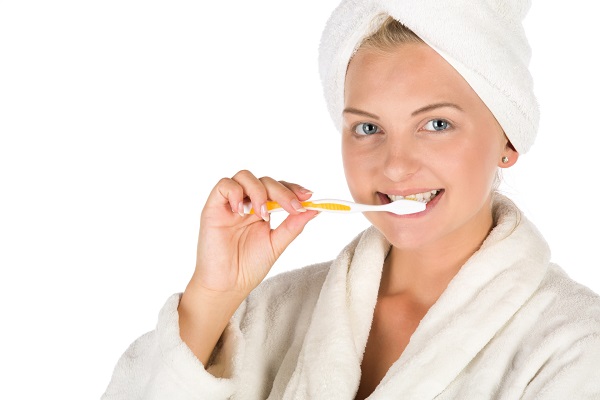Healthy oral hygiene is a must for many reasons. For starters, it helps to prevent bad breath and improve the look of your smile. It also helps prevent costly dental procedures in the future. Our article is going to teach you how to care for your teeth using five easy tips that include choosing the right toothpaste, learning the proper brushing technique, flossing, and going for an antiseptic mouthwash.

What Is Good Oral Health?
When you are first learning how to have good oral health, it’s important to start with the basics of what defines it. The most important thing to remember is that good oral health is defined by a multitude of different factors.
For healthy oral hygiene, you must focus on all the different areas of your mouth. The most basic is your teeth. This is usually accomplished by selecting an appropriate toothpaste to prevent tooth decay. You also can’t forget to address the small areas between your teeth as well.
Things are usually rounded out by investing in a good mouthwash and visiting your dentist at least twice a year for a thorough exam and cleaning. However, these specific tasks will be covered in greater detail in the next section.
Just remember that good oral health will address the root causes of tooth decay. It will also help reverse the course of demineralization and seek professional repair of teeth that are already compromised. Continue reading to discover how you can develop your own oral care routine.
5 Oral Health Tips For Proper Dental Care
1. Select the Right Toothpaste
Before we start discussing brushing techniques, it’s important to select the right type of toothpaste for a healthy oral hygiene. Most dentists will strongly recommend that you invest in a toothpaste that features fluoride as an active ingredient.
The reason for this is that fluoride helps your teeth remineralize. Each time you eat acidic foods and beverage, your teeth are being worn down slowly. Fluoride combats this by strengthening your teeth and helping to reverse the damage that is already done.
Another ingredient that is commonly used in toothpaste is Triclosan. This is an antimicrobial ingredient that is used to reduce bacterial counts in your mouth. For users with certain conditions like advanced gum disease, your dentist may recommend using a toothpaste with this ingredient for improved results.
2. Learn the Proper Brushing Technique
You would be surprised how many people don’t know how to use their toothbrush effectively. To start, keep your brush at a 45-degree angle. You should lightly move the brush back and forth across your teeth horizontally along the front. Try to use a motion that doesn’t cover more than two or three teeth at a time.
The key thing to keep in mind is that you should always be using light amounts of pressure. The bristles should be allowed to naturally dip between each tooth and to glide across the tooth’s surface. This also has the added benefit of reducing the wear and tear on your bristles.
You have to remember to address all of the surface areas of your teeth. To reach the back areas of your front teeth, rotate the brush vertically and lightly stroke up and down. Remember to also brush along the chewing surfaces of your back teeth as well.
You should finish your brushing routine by brushing your tongue to remove excess surface bacteria. This has the added benefit of promoting fresh breath as well. Each brushing session should take approximately two minutes and should be done a minimum of two times a day.

3. Don’t Toss The Floss
Proper brushing habits and the use of mouthwash are not an alternative for flossing. The reason for this is that floss can reach down into places that your brush can’t. If those types of deposits are allowed to build-up, your mouthwash won’t be able to reach your tooth’s surface effectively.
While flossing can seem difficult at first, it’s an activity that generally gets better with practice. Just remember to use a gentle sawing motion while flossing. You should be flossing using a “C” shape around each tooth.
Don’t forget to carefully glide the floss slightly under the gum lining by each tooth. This is an area that is often neglected where plague and bacteria tend to build-up rapidly. If you find that traditional floss is too difficult to use due to mobility problems, consider opting for a flossing product like DenTek. These typically feature floss that is suspended by a convenient carrying handle for easy application.
4. Choose an Antiseptic Mouthwash
Mouthwash comes in a wide range of types. When in doubt, it’s best to consult with your dentist to see what recommendations they have for your given situation. However, the two most common we will discuss are alcohol-based and non-alcohol mouthwashes.
One of the most popular mouthwash brands available is Listerine. Their original formula is alcohol-based and includes several essential oils like eucalyptus. These ingredients are great for reducing bacteria counts in your mouth and reaching deep into the nooks and crannies.
The only downside is that the alcohol does tend to burn a bit. In addition, some users have experienced increased dryness from these types of products. In these cases, users may opt for an alcohol-free version instead.
One of the most common ingredients used in these types of mouthwashes is cetylpyridinium chloride. While it’s very effective at killing bacteria, it does have one drawback to consider. It can lead to increased surface staining on your teeth. However, this is temporary and can easily be removed by your dentist or hygienist during your next cleaning.
5. Keep Your Dental Appointments
The last tip to remember for healthy oral hygiene is that you should always keep your dental appointments. For most individuals, you should see your dentist twice a year. You will receive a thorough examination by your dentist and will likely have an x-ray done as well.
This will allow your dentist to check for signs of tooth decay and make any appropriate recommendations that they find necessary. You will also receive a thorough cleaning from a trained hygienist as well. This is particularly important since there are areas that they can reach that you cannot in your daily dental care routine.
For patients with conditions like periodontitis, it may be recommended to visit the dentist more often. When in doubt, just remember to follow the recommendations of your dentist for the best results.
Conclusion
The important thing to remember about healthy oral hygiene is that it is an ongoing process. You must always do your part by making sure you complete all the steps in your individual daily routine. If there are healthy oral hygiene tips that you would like to share, feel free to post them in the comments section.

Leave a Comment